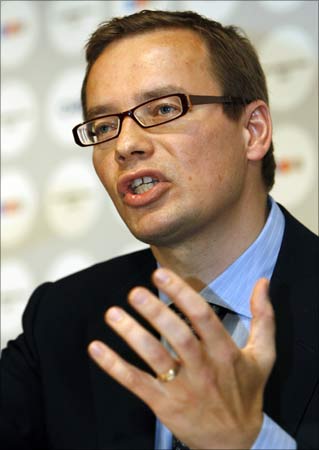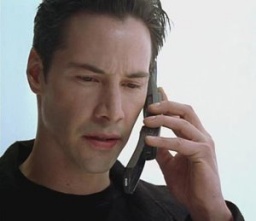Update: Analysts respond in a separate post.
 Nokia is the world’s biggest mobile gadget maker, period. More people around the world pack a Nokia phone than the company’s next three competitors combined. Nokia’s brand is rated as one of the top names in the world, not far behind Google and Coke.
Nokia is the world’s biggest mobile gadget maker, period. More people around the world pack a Nokia phone than the company’s next three competitors combined. Nokia’s brand is rated as one of the top names in the world, not far behind Google and Coke.
But here in the States, I had trouble finding a Nokia phone I could buy this past week. None of the company’s best models are available in phone stores in the rich-geek neighborhoods of downtown San Francisco. Why is that?
I took a walking tour of the four largest U.S. carriers’ flagship San Francisco stores. AT&T had the best availabile Nokia, an E71 with QWERTY keyboard for $50 with a two-year plan. T-Mobile at Embarcadeo Center had a $10 2720, a $20 5130 and one remaining 5610 Xpress Music phone.
Verizon, by far America’s biggest wireless operator, had no Nokias onsite. The company carries two lower-end models online, but not at its Market Street store. Sprint has no Nokias at all, not even online.
Radio Shack’s showroom had several low-end Nokias with either prepaid plans, or no plans, priced at $20 to $40. “Gangster phones,” a friend dubbed them, because he couldn’t imagine a grownup with a regular-paying job buying a Noke after seeing the Shack’s free high-end BlackBerry phones from Sprint, AT&T and T-Mobile on display a few feet away.
Nokia’s new N900 “mobile computer,” as the company calls it, is Nokia’s first smartphone worthy of the name. In the USA, I challenge you to spot one in public.
How could Nokia be so huge everywhere else, and so far behind in America? I contacted more than a dozen analysts and journalists, as well as several PR people at Nokia, to get past the accepted wisdom on blogs. What really happened to Nokia, the company that made Keanu Reeves’ sexy snap-open phone in The Matrix?
Respondents who cited sources, rather than just passing along gossip, claimed three separate reasons for Nokia’s failure in the USA.
Nokia was too cocky in negotiations with U.S. operators
 “Carriers want their services, games, app stores, etc,” respected analyst Michael Gartenberg told me during an email back-and-forth. Nokia, instead, wants to push its own Ovi store and its own entertainment services, a huge initiative led by senior vice president and resident visionary Tero Ojanperä.
“Carriers want their services, games, app stores, etc,” respected analyst Michael Gartenberg told me during an email back-and-forth. Nokia, instead, wants to push its own Ovi store and its own entertainment services, a huge initiative led by senior vice president and resident visionary Tero Ojanperä.
“We will quickly become the world’s biggest entertainment media network,” Ojanperä told an audience in New York City last year. Tero’s pitch is captivating and convincing. Yet it’s easy to imagine American operators balking at the idea of becoming what they themselves call “dumb pipes” for Nokia’s content.
“Of course only Nokia and the carriers know the real issues,” Gartenberg warned. “The rest of us are speculating.” But Gartenberg thinks there’s truth to the talk that Nokia stuck to demands which U.S. wireless carriers — much more powerful and tyrannical than most of their global counterparts — refused to accomodate. Specifically, Nokia allegedly wanted to allow customers to switch carriers, and to brand the phones as Nokia’s rather than the carrier’s.
Good luck with that. My BlackBerry has a Verizon logo on its chin the exact same size as the BlackBerry moniker on its forehead. It signs my emails with, “Sent from my Verizon Wireless BlackBerry.” In America, the carrier’s brand name goes first.
Nokia’s phones are no longer the sexiest
In December 1999, I vividly remember spending over my budget to buy my wife and myself shiny chrome-plated Nokia 8810 phones, with slide-open covers that turned heads at swanky cocktail bars. Years later, I use it as a retro paperweight on my desk. Visitors are compelled to pick it up and play with it.
 And everyone remembers wanting Keanu Reeves’ Nokia 8110, with its spring-loaded keypad cover, from the genre-defining movie The Matrix. (You can relive Keanu’s snap-open surprise on YouTube.)
And everyone remembers wanting Keanu Reeves’ Nokia 8110, with its spring-loaded keypad cover, from the genre-defining movie The Matrix. (You can relive Keanu’s snap-open surprise on YouTube.)
It may have been a glimpse of Nokia’s future that they didn’t make Reeves’ phone available to trendy, spendy Americans.
Today, I can’t find a single analyst or reporter who thinks Nokia’s phones are on par with Apple’s iPhone, Google’s Nexus One, Motorola’s Droid, or Palm’s Pre. Even if that’s unfair, it’s the public perception: Nokias are gangster phones.
Nokia no longer leads on features
This morning in Barcelona, at the giant Mobile World Congress conference, Nokia and Intel announced MeeGo, a Linux-based, open-source operating system for the phone with support for developing third-party apps. MeeGo is the company’s answer to Google’s Android. But see? Even here, Nokia is following rather than leading. Android phones have already staked out turf among the Linux crowd, and also among phone buyers who don’t know what Linux is, but who nonetheless consider the Droid and Nexus One better than an iPhone.
Will Nokia hit upon a killer feature that lures those buyers away? If so, it probably needs to come from within the company, not the app store. Think of the iPhone’s gesture-based UI, poorly copied by competitors with touchscreens you can only tap on. That capability was designed and built into the iPhone’s touchscreen by Apple. It’s not something a third party could add. Same for the Nexus One’s clever noise-canceling hardware.
What does Nokia need to win back America?
CEO Olli-Pekka Kallasvuo has acknowledged the company’s failings in dealings with U.S. operators. He’s vowed that Nokia will come back and do what it takes to get its best phones in front of American buyers.
Most encouragingly, he’s stuck to the Nokia party line that instead of one-size-fits-all iPhones for everyone, different markets need different phones.
That means Nokia is probably working on a phone specifically designed to take back the U.S. market. Here, we expect our smartphones to be cheap (thanks to carrier subsidies as high as $350 for an iPhone) and our monthly bills to be high. That’s the opposite of most of the rest of the world, where the $32 unsubsidized Nokia 1616 rules. We tote expensive laptops and cheap netbooks and work at powerful big-screen desktops, rather than owning only a cellphone as do Nokia’s customers in many other lands. That changes the phone’s role in our lives.
To win back American buyers, Nokia needs to do more than show up in the touchscreen-and-open-source corner of a Gartner magic quadrant. It needs to shake the gangster-phone stigma. It needs to shock and rock spoiled Americans.
What Nokia needs is a new phone — sorry, N900 — that’s as startling and lust-provoking as Keanu’s snap-open model was eleven years ago. If there’s a Star Trek sequel, it should be plugged into the cigarette lighter in young James Kirk’s vintage Corvette Stingray.
Sure, we’ll yak about features and compatibilities and licensing models and app store rules all day on Twitter. But Nokia could shut us all up with the right piece of hardware and the right high-exposure marketing for it. I don’t care what operating system it runs. I only care that when I see it in someone else’s hands, I have to grab it.

